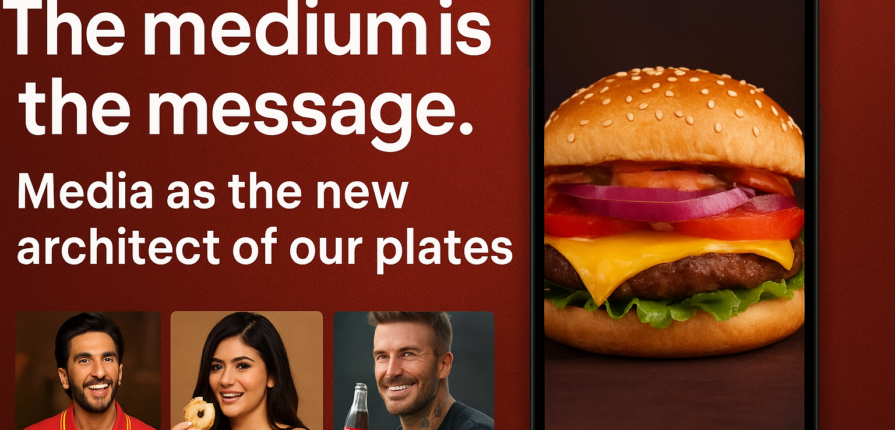“The medium is the message.” McLuhan’s timeless insight feels more alive than ever on our plates. In today’s world, media doesn’t just tell us what’s cooking—it decides what we crave. A burger endorsed by a Bollywood star, a dessert trending on Instagram reels, or a meal nudged by a delivery app algorithm — none of these are about food alone. They’re about the way media frames it. Hunger, once a biological signal, is now mediated by screens, stories, and scrolls.
Our choices are less about tradition or taste, and more about the lens through which food reaches us. In this sense, media has quietly become the new chef of our appetites
Television & Advertisements – Manufacturing Desire
From Coca-Cola’s festive jingles to McDonald’s celebrity endorsements, TV ads don’t just show food — they engineer appetite. Studies show that exposure to fast food ads significantly increases consumption of high-calorie snacks among children and adults (Harris et al., 2009, Health Psychology).
In India, celebrities like Ranveer Singh promoting McDonald’s burgers or Alia Bhatt endorsing Frooti blur the line between branding and reality — do we really think these stars eat these foods regularly, or is it simply performance-driven persuasion?
Social Media Influence – From Reel to Real Cravings
Platforms like Instagram, YouTube, and TikTok are no longer just entertainment — they’re food trend incubators.
- Viral dishes like Korean cheese pull sandwiches, tandoori chai, or butter boards spread not by chefs but by creators.
- Research shows that food-related social media exposure increases desire for energy-dense foods and impulsive eating (Folkvord et al., 2020, Appetite).
When a reel of molten chocolate lava cake racks up millions of views, it doesn’t just entertain — it alters demand, often within days.
Food Delivery Algorithms – The Invisible Hand of Cravings
Swiggy, Zomato, Uber Eats — they’re not just couriers; they’re behavioral architects. Algorithms push “Top Picks For You” or “Trending Near You,” which nudge users toward calorie-dense meals.
- A 2021 study in Public Health Nutrition found that food delivery app promotions disproportionately feature fast food, fried items, and sugary beverages, increasing the likelihood of unhealthy orders.
- Apps also exploit temporal hunger windows: midnight push notifications tap into late-night snacking, driving impulsive, high-calorie purchases.
In effect, your dinner is not just chosen by you — it’s co-authored by machine learning.
Real-World Examples
1. Coca-Cola & Pepsi in India
Coca-Cola’s campaigns during cricket matches and festive seasons are not about the drink itself — but about associating it with celebration and togetherness. McLuhan would say the medium (mass advertising during cricket) became the message, making Coke synonymous with Indian celebrations.
2. McDonald’s Masala Burger
McDonald’s doesn’t just advertise food — it localizes menus and promotes them heavily through digital channels. The constant reinforcement through billboards, TV ads, and influencer promotions reshapes food habits, making a fast-food culture more acceptable in traditionally home-cooked-food households.
3. Influencer-Driven Nutrition Trends
Avocado toast, quinoa, kombucha — once niche, now mainstream. Why? Because Instagram made them aspirational. Studies show that social media “food porn” influences eating behavior and food choices in real-time (Turner & Lefevre, Appetite, 2017).
4. Swiggy & Zomato Push Notifications
Media is now interactive. These apps use push notifications like “Your favorite biryani is 20% off” during lunch hours — tapping into circadian eating habits and hunger cues. Here, the medium (mobile notification) is more powerful than the message itself.
New Research Insights
- Digital Marketing & Children: A 2022 systematic review (Nutrients Journal) showed that children exposed to junk food ads on YouTube are more likely to increase calorie intake within 24 hours.
- Food Trends and TikTok: A study in Frontiers in Psychology (2023) revealed TikTok’s viral recipes (like whipped coffee, baked feta pasta) significantly influenced grocery shopping patterns in the US and Europe.
- Indian Context: According to FSSAI (2024), 62% of adolescents in urban India are influenced by digital ads when choosing packaged snacks.
Global Comparisons
- 🇺🇸 US: Media-driven diets (Keto, Paleo, Vegan challenges) often gain traction through celebrity endorsements on Instagram and podcasts.
- 🇰🇷 South Korea: “Mukbang” trend (watching influencers binge eat) impacts portion sizes and eating frequency among youth (Nutritional Research, 2021).
- 🇮🇳 India: Food delivery ads and cricket sponsorships drive fast-food consumption more than direct health/nutrition campaigns.
Way Forward: Responsible Media for Healthier Choices
If McLuhan’s theory tells us that media shapes perception more than content itself, then the responsibility lies in how food companies, influencers, and policymakers use media.
- Policy Change: Strict regulation of junk food ads targeting children (as already seen in Chile & UK).
- Nutrition Communicators: Dietitians using social media to make millets, legumes, and local foods aspirational.
- Corporate Role: Partnerships where brands promote healthier items (e.g., Subway promoting whole-grain bread).
Conclusion
McLuhan’s theory was ahead of its time. Today, in the era of Instagram reels and AI-driven ads, the medium doesn’t just carry the message — it creates desire and choice itself. Whether we pick up a Coke during cricket or try quinoa after seeing it on Instagram, our plates are being silently curated by media.
The real question is: Can we use the same media power to make healthier choices aspirational?
Point to reflect on: It’s not about whether Ranveer Singh or Alia Bhatt actually eats these foods. The media portrayal is enough to shape our cravings and normalize fast food culture, especially among India’s young, urban consumers.
References
- Turner PG, Lefevre CE. (2017). Instagram use is linked to increased symptoms of orthorexia nervosa. Appetite, 108.
- Smith R. et al. (2022). Digital marketing of unhealthy foods to children: A systematic review. Nutrients, 14(2).
- Lee J, Kim Y. (2021). Influence of Mukbang on eating behavior. Nutrition Research.
- FSSAI (2024). Youth food consumption and digital influence survey.
- Zarnowiecki DM et al. (2023). Social media trends and food purchasing. Frontiers in Psychology.

